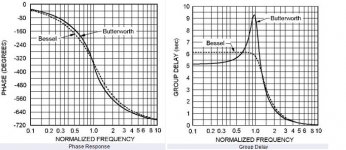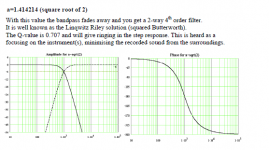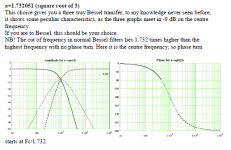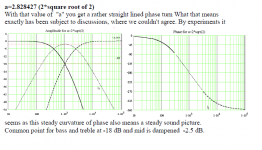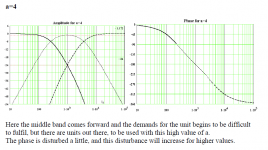Passive is not passe and 99% of speakers are still crossed over that way. That said, one cannot deny technology or its place. A Meniscus Audio passive vs. Minidsp test was done to a group of DIYers at a DIY event. The speakers and x-overs were concealed. The majority voted for the passive over the DSP when A/B'd in what is known as a very good two-way speaker. Certainly not a definitive survey, but an interesting one. As chips get better I can see DSP as being used in the majority of x-overs some day. I marvel each time I hear SL's XL-Mini speaker. It is wonderful and uses a Minidsp for x-over, heavy EQ and other duties, and as DAC. Both passive and DSP require quality execution. Tech tools are fun, too!
Here we go, all analog: http://www.diyaudio.com/forums/multi-way/309856-tweeter-set-vs-pass-delay-3.html#post5129157I hope the people that posted on this thread, claiming they can do as good with IIR will share the results and details how they got there. What good is the claim to have it, if you don't share how it's done. I suppose that would have been your next move, if there were any interest?
I hope you do share what you did and how you got those results, there's always people watching (and learning). There will always be contradictory views as well.
These are target functions, of course, not actual filters for specific drivers. The needed filters are synthesized as usual, by fitting the magnitude and phase of the EQ'd driver to the target. Also, there is no low freq XO in the example which would need to be factored in as well.
Details on allpass implementation: http://www.diyaudio.com/forums/anal...ss-filter-design-questions-2.html#post5073813
This relative simple method is restricted to XO's above 2kHz or so for practical reasons (even with optimum setback of the higher way the allpass cascade will grow subtantially for lower XO freqs and will be much harder to tune properly).
With IIR when we also have true delays there are other methods, notably delayed subtractive crossovers. See for example the paper by John Kreskovsky, "A New High Slope, Linear Phase Crossover Using the Subtractive Delayed Approach".
At the end of the day I mostly still prefer bog-standard LR etc filter targets and apply FIR phase-unwrapping globally to the source. When the playback is digital from a PC this unwrapping is very easily implemented.
Passive is not passe and 99% of speakers are still crossed over that way. That said, one cannot deny technology or its place. A Meniscus Audio passive vs. Minidsp test was done to a group of DIYers at a DIY event. The speakers and x-overs were concealed. The majority voted for the passive over the DSP when A/B'd in what is known as a very good two-way speaker. Certainly not a definitive survey, but an interesting one. As chips get better I can see DSP as being used in the majority of x-overs some day. I marvel each time I hear SL's XL-Mini speaker. It is wonderful and uses a Minidsp for x-over, heavy EQ and other duties, and as DAC. Both passive and DSP require quality execution. Tech tools are fun, too!
Which chips are you talking about? The available DSP hardware is already incredibly potent; eg a RPI 3 can do 4 way at double precision into 192k sample rate with respectably long filter lengths. Dedicated consumer audio DSP chips are a bit less, but still not a bad bom. Decent chip amps abound, depending on ones level of discernment/fussiness, and benefit from mild impedance curves to work into versus a passive 4 way.
A passive 4 way sounds awful to design, to be honest. Hybrid active/passive is another story.
Dtaylo: could you detail the chain used in this test? I bet the mini dsp was used as an ad/da in an analog path... ( minidsp does have suboptimal ad/da imho).
But this is not the subject of OP. Mark talked about fir/iir difference and not analog/digital. In my experience xover with good fir implementation used in the mid/ high frequency range does sound quite good.
Once you try to compensate for everything using them (drc) things have a tendency to get not as good as one could expect.
But this is not the subject of OP. Mark talked about fir/iir difference and not analog/digital. In my experience xover with good fir implementation used in the mid/ high frequency range does sound quite good.
Once you try to compensate for everything using them (drc) things have a tendency to get not as good as one could expect.
To quote Floyd Toole:
We still have much to learn about measures and how to interpret them.
Saying that a measurement proves something is audible or not is a subjective choice that asserts the measurement can actually do that.
dave
Were talking about vibrating air molecules in a pattern here. It is so extremely unlikely their is hidden voodoo magic in a passive filter that its just not feasible. Take a step back and really think about that conviction.
When
The speaker is the same.
The amp is the same.
The recording is the same.
The DAC is the same.
The room and the speaker position is the same.
But one speaker has:
ruler flat FR, phase, almost perfect impulse response, and can almost produce square waves.
The other has:
flat +/- 2db, time delays between drivers, phase irregularities all over the place, post ringing.
One is almost producing the sound on the recording, the other is not.
This isn't valves vs solid state. Were talking about REMOVING components from the signal change AND improving every measurable field.
I like the sound Of 1-3% added 2nd order distortion to audio tracks, but its not what the band recorded.
What's to argue.
Well, since this a DIY audio forum thread, just about everything is candidate for debate - including which colo(u)r of socks to wear when listening.
I heard tale of a DIY listening session in which grey vs black vs argyles were tested, and the outcome was unanimous
no, I just made that up - or did I?
oh, by the way, can you reveal the identity of that first, essentially perfect transducer?
I heard tale of a DIY listening session in which grey vs black vs argyles were tested, and the outcome was unanimous
no, I just made that up - or did I?
oh, by the way, can you reveal the identity of that first, essentially perfect transducer?
I'm having difficulty, is this word play by Toole? What does he mean by analytical? I would think an analyzer by definition is analytical.To quote Floyd Toole:
Two ears and a brain are massively more analytical and adaptable than an omnidirectional microphone and an analyzer.
1 fs order digital filter is audible, imagine 4x 4th order, I think at this point the brain just quits. How the drivers will produce this sound is a very different matter, with the full spectrum of frequencies the drivers are better behaving.
4 gears car transmission, each gear a different wheel and different motor, makes no sense.
I salute those who have the courage to listen to such a system.
4 gears car transmission, each gear a different wheel and different motor, makes no sense.
I salute those who have the courage to listen to such a system.
Pure wool socks for me, for obvious reasons.
sure, but what breed of sheep, or llama or alpaca ?
Take a step back and really think about that conviction.
I certainly have (lots & lots of thinking (and learning) over the last 45+ years), and like Toole and Novick (and Olson), our measures have yet to capture everything that counts. Making the assumption that it does is a subjective choice.
This is not about active or passive, digital or analog, it is about what you use to judge the end result. Measures certainly have their place, but they have limitations as well.
dave
Clearly this thread is descending into woollyness. 
As it goes, I did all this group delay and phase stuff 30 years ago at University postgrad level.
How it works, is any real-world filter produces group delay, increasingly with steepness as in the shallow Bessel versus steeper Butterworth example below. The response is always after the input in the real world.
I don't know how audible it is really. Single driver headphones are pretty good on group delay, and yet not THAT outstanding. HOWEVER, it is possible with IIR digital filtering to correct any group delay or phase error. Audio people are probably less interested than developers of military Radar systems, which rely on sharp impulses to detect a target.
If you knew what the target loudspeaker is, you could doubtless manufacture a CD with a prealigned phase or group delay correction for perfect impulse response. Unfortunately every loudspeaker is different, so it wouldn't be one size fits all. Perhaps Apple could make the MacSpeaker and then we would all have to buy MacCDs?
Sometimes my brilliance amazes even me!
TBH, putting serious hat on, I think distortion in speakers is a more pressing issue. And we could all work at our room acoustics.
As it goes, I did all this group delay and phase stuff 30 years ago at University postgrad level.
How it works, is any real-world filter produces group delay, increasingly with steepness as in the shallow Bessel versus steeper Butterworth example below. The response is always after the input in the real world.
I don't know how audible it is really. Single driver headphones are pretty good on group delay, and yet not THAT outstanding. HOWEVER, it is possible with IIR digital filtering to correct any group delay or phase error. Audio people are probably less interested than developers of military Radar systems, which rely on sharp impulses to detect a target.
If you knew what the target loudspeaker is, you could doubtless manufacture a CD with a prealigned phase or group delay correction for perfect impulse response. Unfortunately every loudspeaker is different, so it wouldn't be one size fits all. Perhaps Apple could make the MacSpeaker and then we would all have to buy MacCDs?
Sometimes my brilliance amazes even me!
TBH, putting serious hat on, I think distortion in speakers is a more pressing issue. And we could all work at our room acoustics.
Attachments
This is why passive crossover is better than digital?4 gears car transmission, each gear a different wheel and different motor, makes no sense.
Let me guess, "downward dynamic range", for example? I wonder how that was captured in the first place.........our measures have yet to capture everything that counts.
OK. Let's have a look at the most theoretically perfect speaker on the Planet.
It's the Steen Duelund Filter.
Duelund was the Einstein of speakers. Because he designed something that works for ANY speaker. He wasn't interested in the details.
Nevertheless he drew some interesting conclusions. I could go into it. But you know all this stuff, don't you.
We have currently reached A= 2 root 2, IMO.
SBAcoustics-3WC
It's the Steen Duelund Filter.
Duelund was the Einstein of speakers. Because he designed something that works for ANY speaker. He wasn't interested in the details.
Nevertheless he drew some interesting conclusions. I could go into it. But you know all this stuff, don't you.
We have currently reached A= 2 root 2, IMO.
SBAcoustics-3WC
Attachments
- Status
- This old topic is closed. If you want to reopen this topic, contact a moderator using the "Report Post" button.
- Home
- Loudspeakers
- Multi-Way
- Why passive is passe ;)
